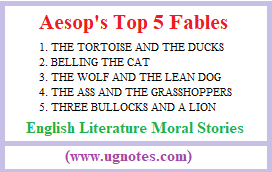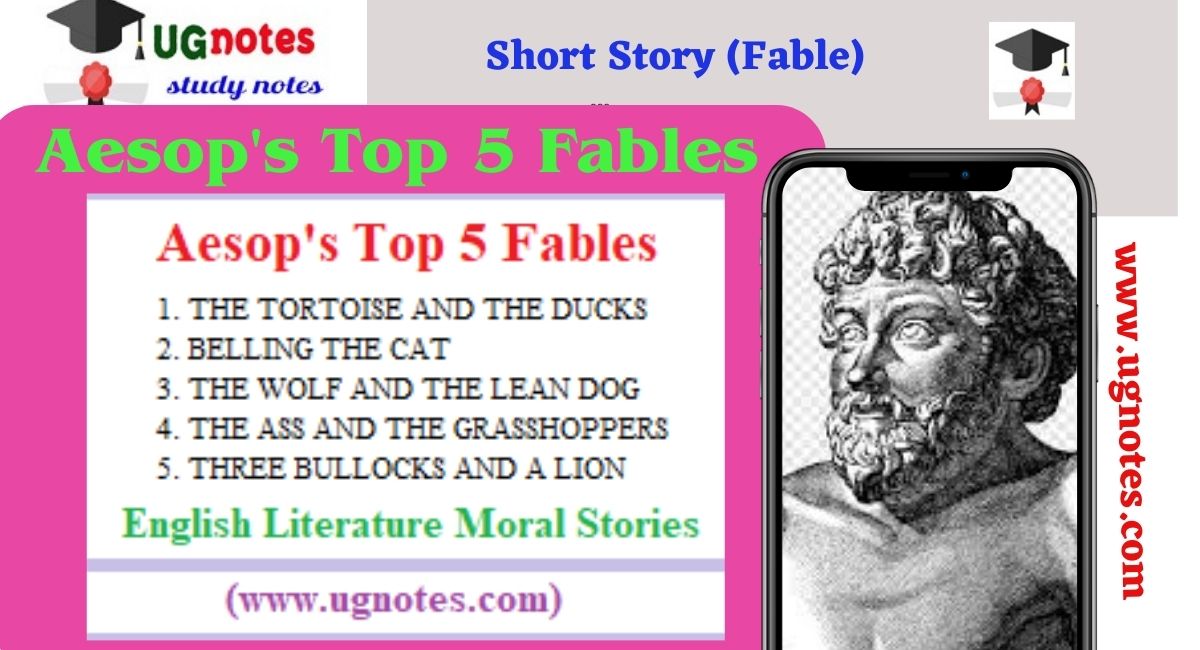(ಪಂಚತಂತ್ರ ಕಥೆಗಳು) Folk literature, Children’s Moral Stories
Bed Time Stories, Like Panchatantra Tales , Fairy Tales.
Aesop’s Top 5 Fables
Fable :- Fable is a literary genre: a succinct fictional story, in prose or verse,that features animals, legendary creatures, plants, inanimate objects,or forces of nature that are anthropomorphized, and that illustratesor leads to a particular moral lesson , which may at theend be added explicitly as a concise maxim or saying. A fable differs from a parable in that the latter excludes animals,plants, inanimate objects, and forces of nature as actors that assumespeech or other powers of humankind. Conversely, an animal talespecifically includes talking animals as characters.
The fable is one of the most enduring forms of folk literature, spread abroad, modern researchers agree, less by literary anthologies than by oral transmission. Fables can be found in the literature of almost every country.

Aesop’s fable :- The varying corpus denoted Aesopica or Aesop’s Fables includes most of the best-known western fables, which are attributed to the legendary Aesop, supposed to have been a slave in ancient Greece around 550 BCE. When Babrius set down fables from the Aesopica in verse for a Hellenistic Prince “Alexander”, he expressly stated at the head of Book II that this type of “myth” that Aesop had introduced to the “sons of the Hellenes” had been an invention of “Syrians” from the time of “Ninos” and Belos . Epicharmus of Kos and Phormis are reportedas having been among the first to invent comic fables. Many familiar fables of Aesop include “The Crow and the Pitcher”, “The Tortoise and the Hare” and “The Lion and the Mouse”. In ancient Greekand Roman education, the fable was the first of the progymnasmata—training exercises in prose composition and public speaking—wherein students would be asked to learn fables, expand upon them, invent their own, and finally use them as persuasive examples in longer forensic or deliberative speeches. The need of instructors to teach, and students to learn, a wide range of fables as material for their declamations resulted in their being gathered together in collections, like those of Aesop.
-
THE WOLF AND THE CRANE
A Wolf had been feasting too greedily, and a bone had stuck crosswise in his throat. He could get it neither up nor down, and of course he could not eat a thing. Naturally that was an awful state of affairs for a greedy Wolf.
So away he hurried to the Crane. He was sure that she, with her long neck and bill, would easily be able to reach the bone and pull it out. “I will reward you very handsomely,” said the Wolf, “if you pull that bone out for me.”
The Crane, as you can imagine, was very uneasy about putting her head in a Wolf’s throat. But she was grasping in nature, so she did what the Wolf asked her to do.
When the Wolf felt that the bone was gone, he started to walk away. “But what about my reward!” called the Crane anxiously.
“What!” snarled the Wolf, whirling around. “Haven’t you got it? Isn’t it enough that I let you take your head out of my mouth without snapping it off?”
Moral:- Expect no reward for serving the wicked
-
BELLING THE CAT
The Mice once called a meeting to decide on a plan to free themselves of their enemy, the Cat. At least they wished to find some way of knowing when she was coming, so they might have time to run away. Indeed, something had to be done, for they lived in such constant fear of her claws that they hardly dared stir from their dens by night or day.
Many plans were discussed, but none of them was thought good enough. At last a very young Mouse got up and said:
“I have a plan that seems very simple, but I know it will be successful. All we have to do is to hang a bell about the Cat’s neck. When we hear the bell ringing we will know immediately that our enemy is coming.”
All the Mice were much surprised that they had not thought of such a plan before. But in the midst of the rejoicing over their good fortune, an old Mouse arose and said:
“I will say that the plan of the young Mouse is very good. But let me ask one question: Who will bell the Cat?”
Moral:- It is one thing to say that something should be done, but quite a different matter to do it.
-
THE WOLF AND THE LEAN DOG
A Wolf prowling near a village one evening met a Dog. It happened to be a very lean and bony Dog, and Master Wolf would have turned up his nose at such meagre fare had he not been more hungry than usual. So he began to edge toward the Dog, while the Dog backed away.
“Let me remind your lordship,” said the Dog, his words interrupted now and then as he dodged a snap of the Wolf’s teeth, “how unpleasant it would be to eat me now. Look at my ribs. I am nothing but skin and bone. But let me tell you something in private. In a few days my master will give a wedding feast for his only daughter. You can guess how fine and fat I will grow on the scraps from the table. Then is the time to eat me.”
The Wolf could not help thinking how nice it would be to have a fine fat Dog to eat instead of the scrawny object before him. So he went away pulling in his belt and promising to return.
Some days later the Wolf came back for the promised feast. He found the Dog in his master’s yard, and asked him to come out and be eaten. “Sir,” said the Dog, with a grin, “I shall be delighted to have you eat me. I’ll be out as soon as the porter opens the door.”
But the “porter” was a huge aDog whom the Wolf knew by painful experience to be very unkind toward wolves. So he decided not to wait and made off as fast as his legs could carry him.
Moral:- Do not depend on the promises of those whose interest it is to deceive you. Take what you can get when you can get it.
-
THE ASS AND THE GRASSHOPPERS
One day as an Ass was walking in the pasture, he found some Grasshoppers chirping merrily in a grassy corner of the feld.
He listened with a great deal of admiration to the song of the Grasshoppers. It was such a joyful song that his pleasure-loving heart was flled with a wish to sing as they did.
“What is it?” he asked very respectfully, “that has given you such beautiful voices? Is there any special food you eat, or is it some divine nectar that makes you sing so wonderfully?”
“Yes,” said the Grasshoppers, who were very fond of a joke; “it is the dew we drink! Try some and see.” So thereafter the Ass would eat nothing and drink nothing but dew. Naturally, the poor foolish Ass soon died.
Moral:- The laws of nature are unchangeable.
-
THREE BULLOCKS AND A LION
A Lion had been watching three Bullocks feeding in an open field. He had tried to attack them several times, but they had kept together, and helped each other to drive him off. The Lion had little hope of eating them, for he was no match for three strong Bullocks with their sharp horns and hoofs. But he could not keep away from that field, for it is hard to resist watching a good meal, even when there is little chance of getting it.
Then one day the Bullocks had a quarrel, and when the hungry Lion came to look at them and lick his chops as he was accustomed to do, he found them in separate corners of the field, as far away from one another as they could get.
It was now an easy matter for the Lion to attack them one at a time, and this he proceeded to do with the greatest satisfaction and relish.
Moral:- In unity is strength.







